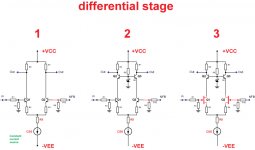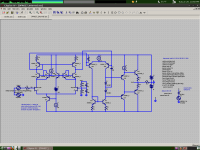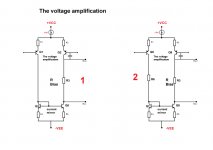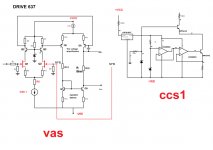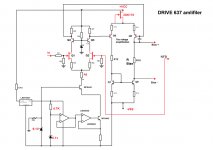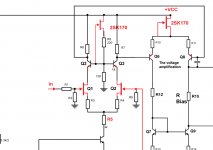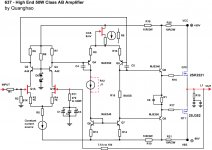Quanghao, the input stage to the OPA6x7 is not a conventional LTP. Notice the phase is actually reversed; the Jfet sources actually point up; they are P-channel. This could give nice advantages to the way compensation is applied.
There are ways to perform this phase reversal with an N-channel or NPN LTP (something like cross-comp) but I think these may cause stability problems.
It would be interesting to see if you can make it work with the same input topology as the OP6x7. Otherwise, the circuit is actually pretty conventional, if performing well.
I TEST ALL , thanks
Attachments
Quanghaou, none of those were the circuit used in the OPA6x7. This is the proper internal schematic. Operating points and transistors were guessed.
Again, notice the LTP is P-CHANNEL. It will not work if you remove Q1, 2, 3, 4 or 6. The input stage is the only thing, based on the datasheet schematic, that makes this opamp unconventional. Else it's just an ordinary opamp.
With discrete components, the amp should probably be converted to use the complementary parts since N-channel Jfets and bipolars will perform better.
Again, notice the LTP is P-CHANNEL. It will not work if you remove Q1, 2, 3, 4 or 6. The input stage is the only thing, based on the datasheet schematic, that makes this opamp unconventional. Else it's just an ordinary opamp.
With discrete components, the amp should probably be converted to use the complementary parts since N-channel Jfets and bipolars will perform better.
Attachments
Quanghaou, none of those were the circuit used in the OPA6x7. This is the proper internal schematic. Operating points and transistors were guessed.
Again, notice the LTP is P-CHANNEL. It will not work if you remove Q1, 2, 3, 4 or 6. The input stage is the only thing, based on the datasheet schematic, that makes this opamp unconventional. Else it's just an ordinary opamp.
With discrete components, the amp should probably be converted to use the complementary parts since N-channel Jfets and bipolars will perform better.
I love your comments!
very useful, thank you very much, I do not know how to use the software you are using!
Quanghaou, none of those were the circuit used in the OPA6x7. This is the proper internal schematic. Operating points and transistors were guessed.
Again, notice the LTP is P-CHANNEL. It will not work if you remove Q1, 2, 3, 4 or 6. The input stage is the only thing, based on the datasheet schematic, that makes this opamp unconventional. Else it's just an ordinary opamp.
With discrete components, the amp should probably be converted to use the complementary parts since N-channel Jfets and bipolars will perform better.
Hi! can you sent help me the file in LTSpice
thanks you hepl!
Quanghao
Here is the simulation file. C4 and C5 have nothing to do with the actual OPA6x7; the high input capacitance of the J109 makes them necessary. I did not take much time to try and choose an appropriate input jfet.
ok i can Test in the Mutisim
Is it a big improvement soundwise?
Yes, i like it!
That complicated CCS is still no better than a 2-Q CCS. The base leakage of the cascode transistor throws away whatever good the opamps do. Cascode with a BC337 and it will be better.
i can see your circuit please??
Just replace the upper MPSA42 with a BC556B, BC560C or BC337.
like information!
thanks
Or just eliminate all that mess with the Op-amps and noisy Zeners and replace it with a Idss, J-fet CCS like is on the differential VAS. Zeners are convinent components but come with a noise price. A Wilson mirror for the VAS would not be a bad addition either. Also, you can replace the cascode Zener with a resistor||COG type cap ~1nf, and replace R8 with another Idss bias J-fet CCS. J-fets are wonderful components to use in audio amplifiers, they have so many uses. I often wonder why they are not used more.
Last edited:
Or just eliminate all that mess with the Op-amps and noisy Zeners and replace it with a Idss, J-fet CCS like is on the differential VAS. Zeners are convinent components but come with a noise price. A Wilson mirror for the VAS would not be a bad addition either. Also, you can replace the cascode Zener with a resistor||COG type cap ~1nf, and replace R8 with another Idss bias J-fet CCS. J-fets are wonderful components to use in audio amplifiers, they have so many uses. I often wonder why they are not used more.
thanks, that you say that???
Attachments
If you are creating, building and testing each circuit variation
then you deserve my congratulations...and your circuit may result unbeatable, as this method of work is perfect...the real world testing, listening and comparing using people to judge sonic differences.
I do not think it is easy to compare, as you will always have A and B and the "audio memory" of C, D, E, F is lost.
What i mean.... you can test A and B and judge A better than B..... so.... A is the winner....now you compare A with C.... and A continue to be the winner....then you compare A with D..... and now D is the winner.
But you will never know the result of the comparison in between D and B for instance..... and B can beat D despite have not beated A because there are several different things to evaluate while listening.
In one case the noise can be the reason to be the winner...in other sittuation, in another test the dinamics can be the reason.... in other testing the tonal ballance (despite flat, real world they have sonic signature that makes each amplifier different when compared to another... electrically flat but never sonically flat).
It is very difficult to evaluate this way.... reason why people goes to simulators and goes believing they can say something...they show numbers...never sonics, when small changes sometimes makes huge differences.
If you manage to compare and found a good method to compare A to B (blind tests for instance...always the same group of people...different music styles.... reversing reference to confuse and to test evaluation... A is changed to B to see if people will vote correctly) then you deserve the congratulations and uncle charlie will assemble your amplifier as no one can beat the most perfect way to do these things.
If you are using simulator only.......then you are fooling yourself and wasting your time my dear friend..... i do imagine you build and listen each option the way i use to do.
I thank god that people like you still exist.... searching and researching...and starting from something that is considered good (the Op amp), not trying to re discover the powder without smoke.
Sound is something to be evaluated by humans...they are made for humans..only humans will feel differences when compared to the reality...simulators are calculators....a machine that produces numbers..we do not listen numbers..we are not digital decoding devices.
regards,
Carlos
then you deserve my congratulations...and your circuit may result unbeatable, as this method of work is perfect...the real world testing, listening and comparing using people to judge sonic differences.
I do not think it is easy to compare, as you will always have A and B and the "audio memory" of C, D, E, F is lost.
What i mean.... you can test A and B and judge A better than B..... so.... A is the winner....now you compare A with C.... and A continue to be the winner....then you compare A with D..... and now D is the winner.
But you will never know the result of the comparison in between D and B for instance..... and B can beat D despite have not beated A because there are several different things to evaluate while listening.
In one case the noise can be the reason to be the winner...in other sittuation, in another test the dinamics can be the reason.... in other testing the tonal ballance (despite flat, real world they have sonic signature that makes each amplifier different when compared to another... electrically flat but never sonically flat).
It is very difficult to evaluate this way.... reason why people goes to simulators and goes believing they can say something...they show numbers...never sonics, when small changes sometimes makes huge differences.
If you manage to compare and found a good method to compare A to B (blind tests for instance...always the same group of people...different music styles.... reversing reference to confuse and to test evaluation... A is changed to B to see if people will vote correctly) then you deserve the congratulations and uncle charlie will assemble your amplifier as no one can beat the most perfect way to do these things.
If you are using simulator only.......then you are fooling yourself and wasting your time my dear friend..... i do imagine you build and listen each option the way i use to do.
I thank god that people like you still exist.... searching and researching...and starting from something that is considered good (the Op amp), not trying to re discover the powder without smoke.
Sound is something to be evaluated by humans...they are made for humans..only humans will feel differences when compared to the reality...simulators are calculators....a machine that produces numbers..we do not listen numbers..we are not digital decoding devices.
regards,
Carlos
I am 50 years long making comparisons, and studying the stuff
I can write a 500 pages book about the subject because the expertise i have developed studying and reading what other folks did.
After finish the book i can write another one explaing how much this method is weak in precision.
In other words...after half century i am still searching for the perfect method ...i hope you have developed something good...if you did, then explain us how you do comparison testing in your amplifier.
It is so complex that people prefere to use simulator and goes believing they found something good because of numbers....not real the stuff....just delirating and dreaming about.
Sometimes the deffects creates lovely effects.... non linearities generates harmonics we may love...the absence of harmonic distortion or low numbers is not a guarantee of audio quality.
Electronic tubes distorts as a hell...and people love it..and they say the best sound comes from tubes....measuring them you will be in panic and will start to perceive how complicated is to evaluate things by measurements..... these awfull things (tubes) sounds really good.
regards,
Carlos
I can write a 500 pages book about the subject because the expertise i have developed studying and reading what other folks did.
After finish the book i can write another one explaing how much this method is weak in precision.
In other words...after half century i am still searching for the perfect method ...i hope you have developed something good...if you did, then explain us how you do comparison testing in your amplifier.
It is so complex that people prefere to use simulator and goes believing they found something good because of numbers....not real the stuff....just delirating and dreaming about.
Sometimes the deffects creates lovely effects.... non linearities generates harmonics we may love...the absence of harmonic distortion or low numbers is not a guarantee of audio quality.
Electronic tubes distorts as a hell...and people love it..and they say the best sound comes from tubes....measuring them you will be in panic and will start to perceive how complicated is to evaluate things by measurements..... these awfull things (tubes) sounds really good.
regards,
Carlos
Last edited:
there are several different things to evaluate while listening.
In one case the noise can be the reason to be the winner...in other situation, in another test the dinamics can be the reason.... in other testing the tonal balance
It is good that you know the various reasons. To complete that, you need to know (you may have already):
1) What causes each of the reasons
2) Effect of those to enjoyment.
3) Priority of the reasons to different people.
If you focus on real world bass quality, you will get the most votes, whether the respondents are from high class audiophile club or from street. Youngsters or naughty old boys.
- Status
- This old topic is closed. If you want to reopen this topic, contact a moderator using the "Report Post" button.
- Home
- Amplifiers
- Solid State
- 637 Amplifiers
